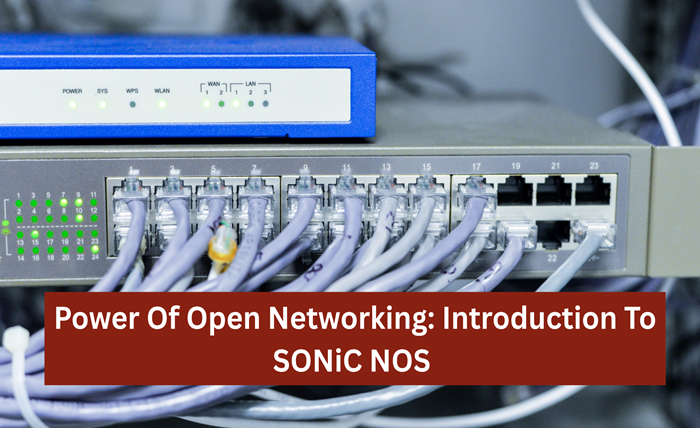
With affordable, scalable, and optimized network solutions now a necessity for business and service providers operating in today’s fast-paced digital world, the limitations of traditional closed networking models have become increasingly apparent.
Closed networking vendors most likely enforce constraints such as lock-in, rigidity, and added expenses within the network.
To solve these challenges, companies are moving towards open networking solutions, which enable them to have more flexibility and innovation.
A key part of this movement is SONiC, the Software for Open Networking in the Cloud, an open source network operating system developed at Microsoft a few years ago to fundamentally change the way we manage networking within a data center and between enterprises.
Having a Linux foundation, SONiC is an open-source, modular platform that offers support for a wide range of hardware and applications.
As it separates hardware from software, SONiC offers unprecedented flexibility and efficiency. The new open networking paradigm is changing the way people connect and how networks are constructed and maintained.
This blog explores the power of open networking with SONiC.

1. Integration with Emerging Technologies
The online world is continuously evolving, and networking solutions should be capable of supporting innovations such as edge computing, artificial intelligence, and machine learning.
The flexibility is among the most critical SONiC design goals and allows it to be integrated with the next generation of technologies. Its open architecture enables developers to add new applications and features in real-time directly on top of the system so that organizations can pre-emptively future-proof their networks.
Enterprises, for example, can connect monitoring tools with AI service agents or on separate edge services without necessarily connecting up to the proprietary systems.
This flexibility is what renders SONiC NOS a strategic resource to companies as they embark on digital transformation.
2. Flexibility through Hardware Independence
One of the best features of SONiC NOS is that it unlinks software from hardware. Older models of networking were vendor-locked in.
Telecommunications companies could only buy a network from one of the vendors, and they would be contracted to the service provider.
The SONiC provides an OS infrastructure where customers can choose their latest hardware. Such liberty lowers the expense and prevents businesses from making modifications to their entire network stack with the sole intention of a hardware update/new deployment.
Further, SONiC’s architecture and multi-hardware vendor support facilitate the uptake of a flexible and scalable system that is capable of catering to the working requirements of organizations.
That degree of agility is vital in today’s fast-moving markets, where businesses need to be able to move fast to adopt new technology and expand user needs.

3. Open-Source Innovation and Community Support
SONiC is helped by an active, healthy, open-source developer and user community that is collaborating on next-generation hardware platforms and the continuous build-out of the platform capabilities and features.
It’s developed, kept up, and published by only a few individuals for the larger development community.
The collaborative system also allows for quicker updates, more frequent features implementation, and improved support than closed systems.
SONiC-based open networking enables openness, as firms can assure themselves that the quality and security they need are indeed in their deployment.
With universal community involvement, SONiC is not only following but also paving the way for interoperability in networking across sectors.
4. Scalability to Meet Growing Data Demands
With online services, cloud services, and Internet of Things solutions prevalent across enterprise configurations, the need for scalable networking infrastructure has surged.
SONiC is based on a modular architecture so that organizations can scale their networks easily.
From scaling data center capacity, via distributed edge network infrastructure or enterprise cloud deployment management, SONiC scales on demand without rip-and-replace. Its modular architecture allows companies to add only necessary modules, thus reducing network management pain and maximizing the utilization of resources.
This scalability makes SONiC an ideal solution for enterprises that want to be ready for the future of data in their business.
5. High Reliability and High Availability
Crashing networks is expensive, not to mention the productivity lost. SONiC is built to be reliable with fast failover, advanced redundancy, and high availability capabilities.
These features guarantee that the network keeps going despite hardware failure or unforeseen interruptions and load.
SONiC empowers companies to construct fault-tolerant networks, which are capable of withstanding the most demanding workloads, by implementing solid configurations over a broad range of devices and software platforms.
This resilience is essential to sectors such as finance, healthcare, and logistics, where constant connectivity is vital to everyday operations and customer support.
6. Simple Network Management
SONiC’s capacity to make what has been a highly specialized and complex network management task in the past so easy is remarkable.
Due to its modularity and availability of shared APIs, SONiC renders the configuration, monitoring, and automation of network devices simple.
With programmable interfaces and established tools, IT teams can program network behavior and automate tasks.
This reduces both administrator training requirements and operational costs. Centralization of management in SONiC enables businesses to gain greater insight and control over their networks, contributing to increased efficiency and quicker response times to any issues.
Final Thoughts
Open networking is revolutionizing the way organizations think about connectivity, and SONiC is at the forefront of this transformation.
Hardware Independence, Open-Source Innovation, Scalability, and High Reliability make SONiC accessible to enterprises, enabling them to design flexible and open networking infrastructures.
It reduces network management and enables new technologies, allowing companies to stay agile in an ever-evolving digital landscape.
Additionally, its cost-effectiveness offers longevity, which further boosts its popularity among companies seeking to maximize performance while keeping costs low.
With an increasing number of digitally focused businesses, reliance on SONiC will be crucial to the growth of positive open networking – revolutionizing what can be done with their infrastructure.




